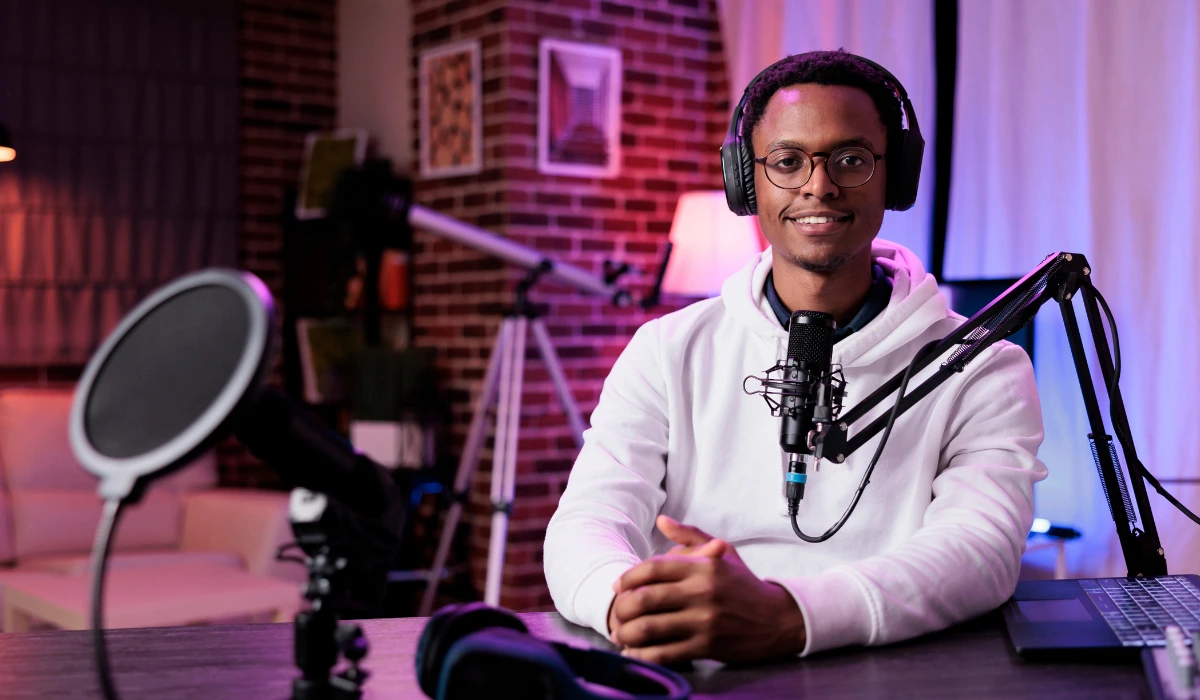“Likes ain’t cash,” says JK Molina, a ghostwriter and brand growth strategist. We all know what he means. As a personal brand or a founder, your goal is beyond collecting likes. It’s to build a profitable audience.
This is especially important in Africa, where youth unemployment is chronic and salaried jobs are scarce. Building an audience that generates trust, leads, and income is a matter of economic liberation.
Take my journey, for example. LinkedIn helped me escape unemployment in Tanzania. From starting with a handful of connections to becoming the most followed Tanzanian marketer on LinkedIn, my personal brand has paid my bills, built my agency Tanzlite Digital, and created a life in the city of Dar es Salaam that would’ve been impossible otherwise.
In 2023, I published my Swahili book Mbele Ya Muda which sold 1.4m TZS in two weeks. About 500,000 TZS of that was in pre-order sales.
This article is a blueprint with practical, psychology-driven steps to grow an audience that makes you money.
Table of Contents
- Start with First Impressions
- Audience Building is Networking
- Following and Getting Followers
- Content Strategy: What to Post
- The 50/40/10 Rule
- Understanding Audience Psychology
- Monetizing Your Audience
- Avoid These Mistakes
- The Bigger Picture
- Next Steps (Where Most Quit)
Part 1: Get Your First Impressions Right
First impressions online work the same as in real life. People size you up in seconds.
On LinkedIn, Twitter, or any platform, your profile is your storefront. If it’s vague or half-baked, you’ll lose before you start.
Key rules:
- Photo: Use a clean, professional photo. Doesn’t need to be studio-quality, just clear and approachable. If you choose to go anonymous on Twitter/X, understand that it comes with an added difficulty to an already harder trust-building process.
- Headline / Bio: Don’t write stuff like “Passionate in AI” or “Data Enthusiast.” Write who you help and how. Example: Helping Tanzanian SMEs turn social media attention into paying clients.
- About section: The about section (on LinkedIn) is not about you. Focus on talking to the reader: their problem and how you solve it.
- Links: Make it easy for people to find your work, whether that’s a WhatsApp link, portfolio, or shop.
Think of this as setting the table before inviting guests. If the table is messy, nobody eats.
I wrote a 34-page guide in Swahili (Tengeneza Profile Mwanzo Mwisho) on profile optimization. If you speak the language, you’ll benefit from step by step implementations with images and illustrations.
Part 2: Audience Building Is Networking
Most people don’t understand that building an audience is building a distribution network.
Forget “growth hacks.” Forget algorithm worship. Audience growth is the digital version of networking. The rules of human connection still apply. What has only changed is the medium.
And the first rule is simple: never show up empty-handed.
When you show up at a party offline, you bring wine, a story, a joke, a vibe. In the online space, your gift is attention.
Reach Across, Not Up
This is where beginners mess up. They chase the big names—commenting under influencers, tagging gurus, aiming for people way above their weight class. It’s like handing a billionaire one dollar. Or being a dude commenting “wow” to an Instagram hot girl.
Instead, start across.
If you have 30 followers, engage with people who have 20. If you have 100, talk to those with 50. These are the people who actually value your attention.
This may feel degrading at first. You’ll spend an hour commenting under small accounts that get 2 likes. You’ll think it’s pointless. But this is how you build your platoon—your first circle of allies.
Not friends. Not clients (yet). But peers with aligned goals.
A handful of these people consistently engaging with you creates perception. Online, perception is gravity. Once 5–10 people lean into your posts, others follow. Social proof is contagious.
That’s how you start looking like “someone.”
Part 3: Following and Getting Followers
Now, let’s get tactical.
- At 0–500 followers: Be a reply guy. Show up in the comments. Don’t just say “Love this take.” Point out what resonated, add one sharp angle, or ask a question. Be specific. Be human. If you go to a big account, don’t comment on the post itself. Comment on a comment of someone within your follower range.
- At 500–1,000 followers: Start publishing niche posts. Lean contrarian if you can—“hot takes” work when they challenge assumptions in your niche. Example: Most Tanzanian SMEs don’t need TikTok. They need consistent WhatsApp broadcasts.
- Beyond 1,000: Build repeatable themes. Inject your signature ingredients your audience can recognise. Share frameworks, stories, and behind-the-scenes lessons.
A note on DMs: once you vibe with someone, move it to private chat. No pitching. Say something like “I’m growing, would love to stay in touch and support each other.” Be genuine, not clever.
Remember: most of your early circle will quit or you will outgrow them. That’s understandable in a long game like this. You have to keep moving.
The Composition of Your Audience
Who makes up your audience matters as much as how big it is. A healthy mix looks like this: half should be your ideal buyers, about 40% peers in your field, and the remaining 10% from complementary disciplines that sharpen your perspective. Too many peers (over 60%) and you end up with empty applause — “facts bro, nakubali kaka” — but no customers.
Still, don’t throw them out completely. Peers fuel the visible conversations that your real buyers often watch in silence. Their comments create social proof, making it easier for your ICP to trust you. The trick is balance. Enough peers to spark activity, but not so many that your feed turns into a vanity echo chamber.
Part 4. Content Strategy: What to Post
Most “personal brands” post blindly. They chase likes, retweets, and applause. But the brutal truth is that not all attention is equal. If your content doesn’t speak to the right layer of your audience’s psychology, you’ll end up entertaining people who will never buy.
Understanding Audience Psychology
Think about your audience through Maslow’s hierarchy of needs. It’s a pyramid.
- Bottom: Survival — food, water, shelter
- Then: Safety — stability, security, less risk
- Above that: Belonging — identity, connection, tribe
- Then: Esteem — respect, status, achievement
- Top: Self-actualization — mastery, potential, legacy
Every single prospect you’ll ever meet is somewhere on this pyramid. If you’re creating content without this in mind, you’ll struggle to pay rent and uplift your living standard.
The uncomfortable truth you need to understand is that most of the internet lives at the bottom. They’re not here to buy. They’re here to escape. Their biggest problem isn’t “lack of leads” or “how to scale” — it’s boredom. That’s why entertainers dominate attention online. Khaby Lame, Kili Paul, Elsa Majimbo, MrBeast, — they sell traffic, not transformation.
If you play their game — optimizing for clicks, laughs, and shock value — you’ll build an audience of scrollers. They’ll smile, tap like, and vanish. No sales. No clients. Just vanity metrics.
If you want buyers, not just followers, your content has to climb the pyramid.
What Changes as You Climb
- Safety tier: These people want stability. They’re looking for competence, reliability, and predictability. Content here is about demonstrating control — systems, processes, structures that reduce risk.
- Belonging tier: These people buy identity. They want to feel seen, represented, and part of a movement. Content that signals “you’re one of us” creates long-term loyalty.
- Esteem tier: Here, the game is status. These prospects want results that make them look sharper, more capable, more credible. If your content makes them feel like winners — respected by peers and competitors — they’ll pay premium rates.
- Self-actualization tier: The smallest tier, but the highest value. These are mastery-driven buyers. They’re already successful, already stable, already respected. What they want now is leverage, legacy, and vision. They will pay top dollar. But only for guidance at the level of strategy, direction, and transformation.
You will notice that the higher you go, the smaller the audience, but the bigger the deal size.
Messaging for Each Tier
If you’re selling high-value expertise, ignore the very bottom. Escapist messaging (“quit your 9–5,” “fire your boss,” “easy money hacks”) gets you engagement — but from the wrong crowd. These followers don’t have buying power.
Instead, focus your messaging higher up the pyramid:
- Safety: Show reliability. Demonstrate you know how to remove chaos and reduce risk. Share frameworks, processes, and case studies that prove stability.
- Belonging: Reinforce identity. Signal that you’re speaking to a specific group, not everyone. Make them feel part of something bigger.
- Esteem: Play to their fear of mediocrity. Position your content as the difference between looking average and looking like a pro. Share proof of results that elevate their status.
- Self-actualization: Stop talking tactics — talk vision. These people don’t need more “how-to.” They want direction, insight, perspective. Show them what’s next.
Bottom line:
- Bottom = empty promises and clicks
- Middle = operations and tactics
- Top = strategy and insight
Climb the pyramid, or stay stuck creating content for people who will never pay you.
Part 5: Monetizing Your Audience
Getting people to finally buy from you is the effortless result of a well-built audience and targeted content. It is not forced because it is the natural outcome of trust.
Some of the best ways to monetize your audience:
- Ebooks and templates (low-cost, high-scale).
- Cohorts or group programs.
- One-on-one coaching or consulting.
- Paid newsletters.
- Sponsorships (once you have reach).
I would avoid selling online courses if I were you. Too many bad actors have given them a bad name. But packaged knowledge in ebooks or workshops still works beautifully.
The key principle here is to sell what you’ve already proven in public. If people engage with your tips on social media, package them. If you’ve been asked the same question 10 times in DMs, turn it into a product.
Now, understanding audience psychology is half the battle. You also need to diagnose the common mistakes solopreneurs make when trying to turn attention into income.
Five Reasons Your Followers Don’t Buy (and How to Fix Them)
You don’t need me to tell you that having followers is not the same as having clients. Many solopreneurs in Dar es Salaam, Nairobi, Kampala, or Kigali have thousands—even tens of thousands—of followers, but their M-Pesa, Airtel Money, or bank balance tells a different story. Why? Because they’re stuck accumulating followers or trying to go viral.
Here are the five biggest reasons your audience isn’t buying—and how to fix it:
1. You show likes, not proof of skill.
People don’t buy tweets or hot takes. They buy outcomes. A fitness coach who only posts selfies gets likes. A coach who posts client transformations gets clients. Same for agencies, consultants, and freelancers. Make sure you share your proof of work. Share before-and-after stories, case studies, and receipts that prove you solve real problems.
2. You act like a low-status account.
Online business is a status game. People follow you because they see signals of authority. If you write like a fanboy, oversell, too many emoji, or seem desperate, they’ll sense the mismatch and back away. Try to carry yourself with composure. Be someone with emotional control and confidence. Avoid Twitter drama —you’re here for deals.
3. You sound like everybody else.
I see many creators cuck themselves by trying to imitate big accounts like Alex Hormozi or Dan Koe. And it is a sad thing to watch. The online game is won by picking a differentiator. I used the term “signature ingredient” somewhere in this article. Maybe you’re the web designer who builds only for B2B SaaS startups, or the copywriter who writes in Swahili and English, or the marketer obsessed with halal products for export. You need to own an angle.
4. You surround yourself with vanity-metric chasers.
Your network shapes your ceiling. If your circle only talks about virality, you’ll think likes are equal to success. Meanwhile, the entrepreneurs talking sales funnels, contracts, and client delivery are cashing in. Make sure you align with peers who are building businesses, not chasing dopamine from likes.
5. You never go outbound.
I have been fortunate to build my business purely inbound. But I understand that sometimes even with status, clients don’t magically appear. Try some outbound if you’re not getting leads. DM people. Start conversations. Offer to help. Collect numbers. Your status will carry you.
Bottom line: You don’t need a huge account. You need a profitable one. If you internalize these five lessons, your audience shifts from passive spectators into paying customers.
Part 6: The Bigger Picture
If you hate the idea of spending your entire professional life building someone else’s dream, your personal brand is your way out.
In Tanzania and across East Africa, this isn’t just “personal branding.” It’s a matter of survival. When jobs are scarce and paychecks unpredictable, your audience becomes your economic engine.
What I have written in this article is not theory. My journey from scratch to running Tanzlite Digital was powered 100% by LinkedIn. Not ads. Not PR. Just consistently showing up, building a platoon of supporters, and publishing trust-rich content.
Part 7: Next Steps (Where Most Quit)
Most people get stuck between visibility and credibility. They either:
- Keep posting without strategy (attention without trust).
- Or they overthink and stop posting at all (trust never gets built).
I don’t want you to be like most people. Here’s how to break through:
- Keep stacking perception. Consistency is more powerful than brilliance.
- Audit your content. Every 30 days, ask: does this content build visibility, credibility, relatability, utility, or inspiration? If not, cut it.
- Shift communities as you grow. Don’t cling to your first circle. Move upward. Support those coming behind you.
- Document, don’t just teach. Share your process, not just polished lessons. People buy from those they’ve watched grow.
If you understand this, you will never be dependent on the job market again.
Closing
Audience building is not a side hobby. It’s leverage. It’s the difference between begging for work and having work chase you.
And the path isn’t mysterious:
- Set your first impressions.
- Build your platoon by reaching across.
- Create trust-rich content.
- Climb the hierarchy of audience needs.
- Monetize naturally, by selling what’s already working.
Do this, and you won’t just collect likes. You’ll collect clients, freedom, and a life on your own terms.
That’s the playbook. Now it’s on you to execute.







Very useful insights..This is one of my best post today..keep it up Brother Shukuru🫡
Thank you brother for stoping by and read. Hope the article helped in evaluating your audience bulding strategy.
If you want to sharpen your Digital Journey,Your in the right place,this article provides a setup on how to build a Profitable audience,Thanks to the whole Tanzlite Digital team for this.
Thanks Agape! It’s our ultimate goal to help African youths build profitable personal brands.
This is a really good article. I’ve learned some new things and also found others to add to my personal journey of self improvement.
Thank you so much, bro Shukuru.
Thank you for reading and leaving a commnet.
I have read again and again Mr Shukuru and I will still read again
Thank you Stuart, please also share it to those looking to build a personal brand online.
I love this school of thought . I have taken notes
Glad to hear you found the article worth noting!